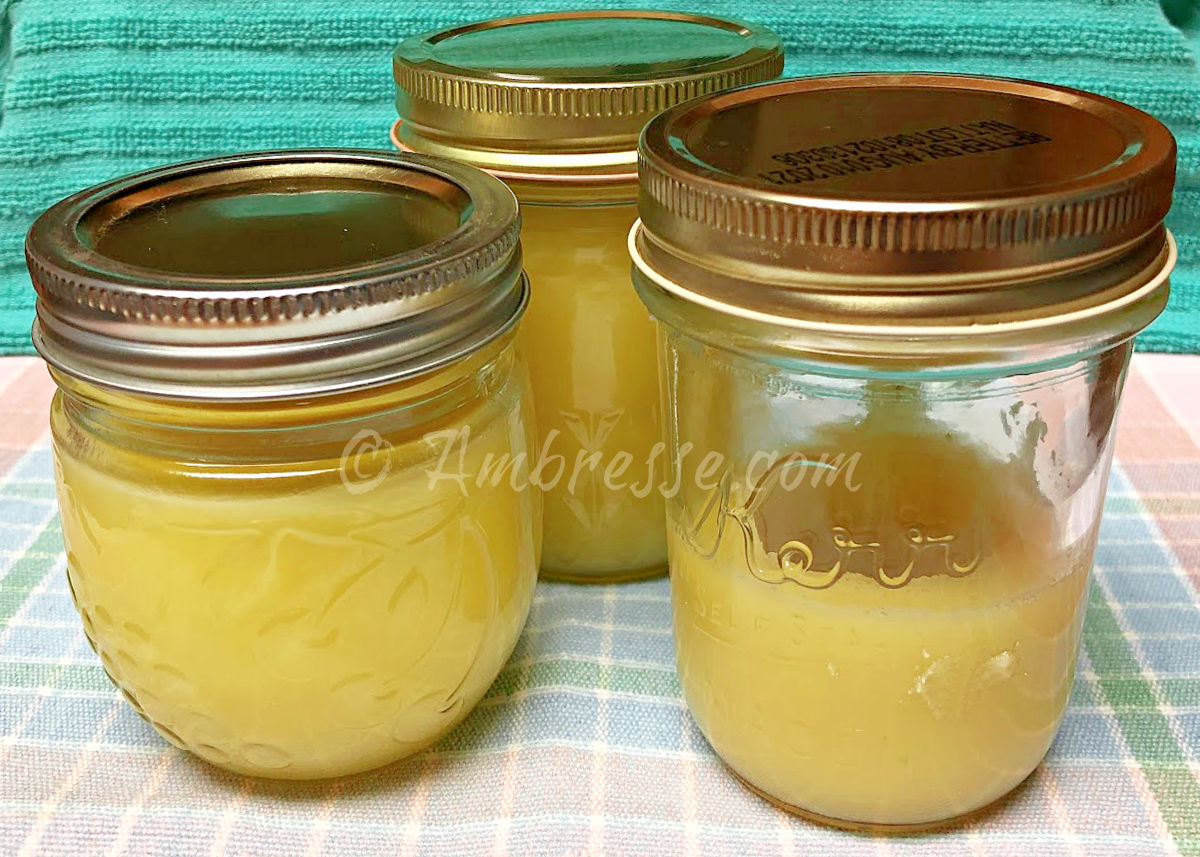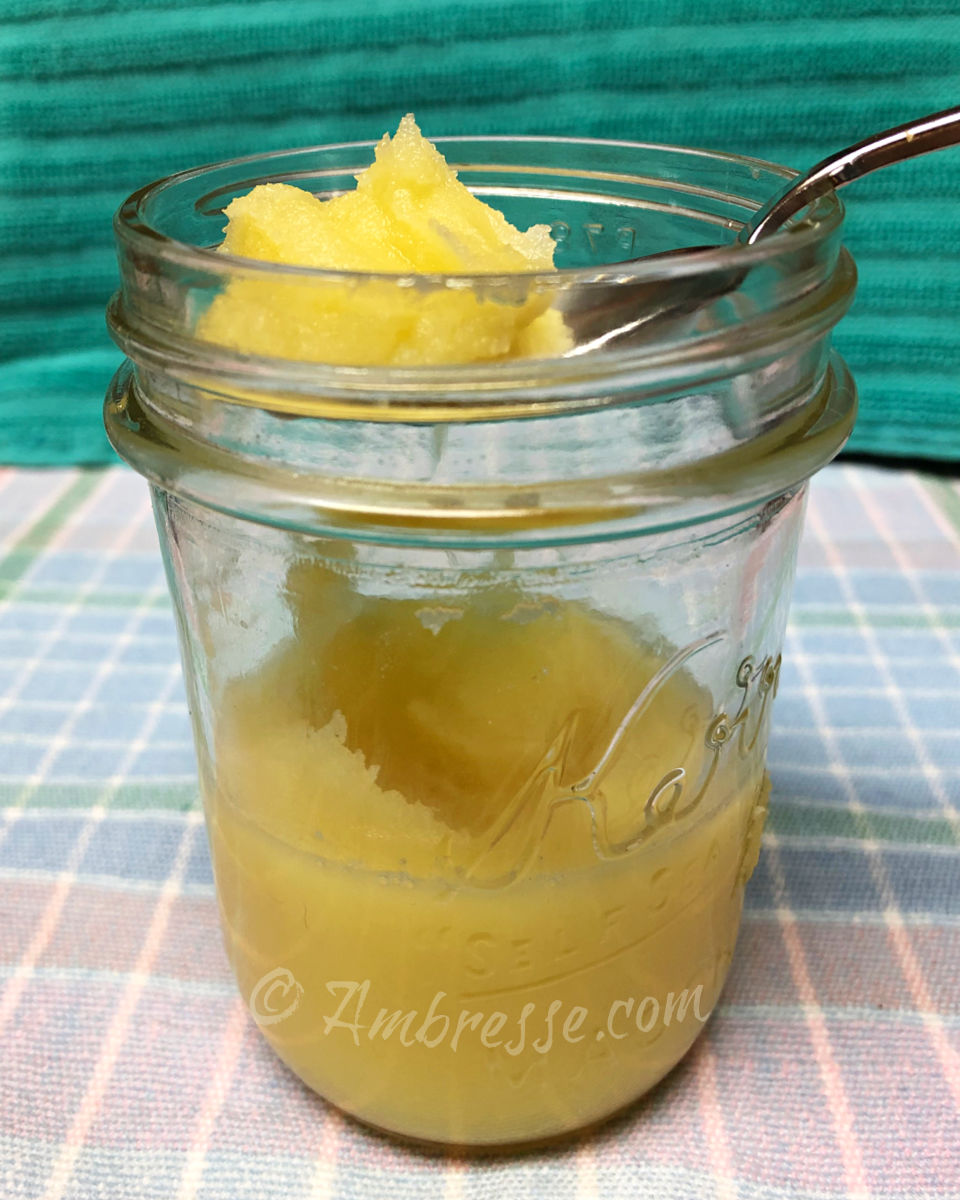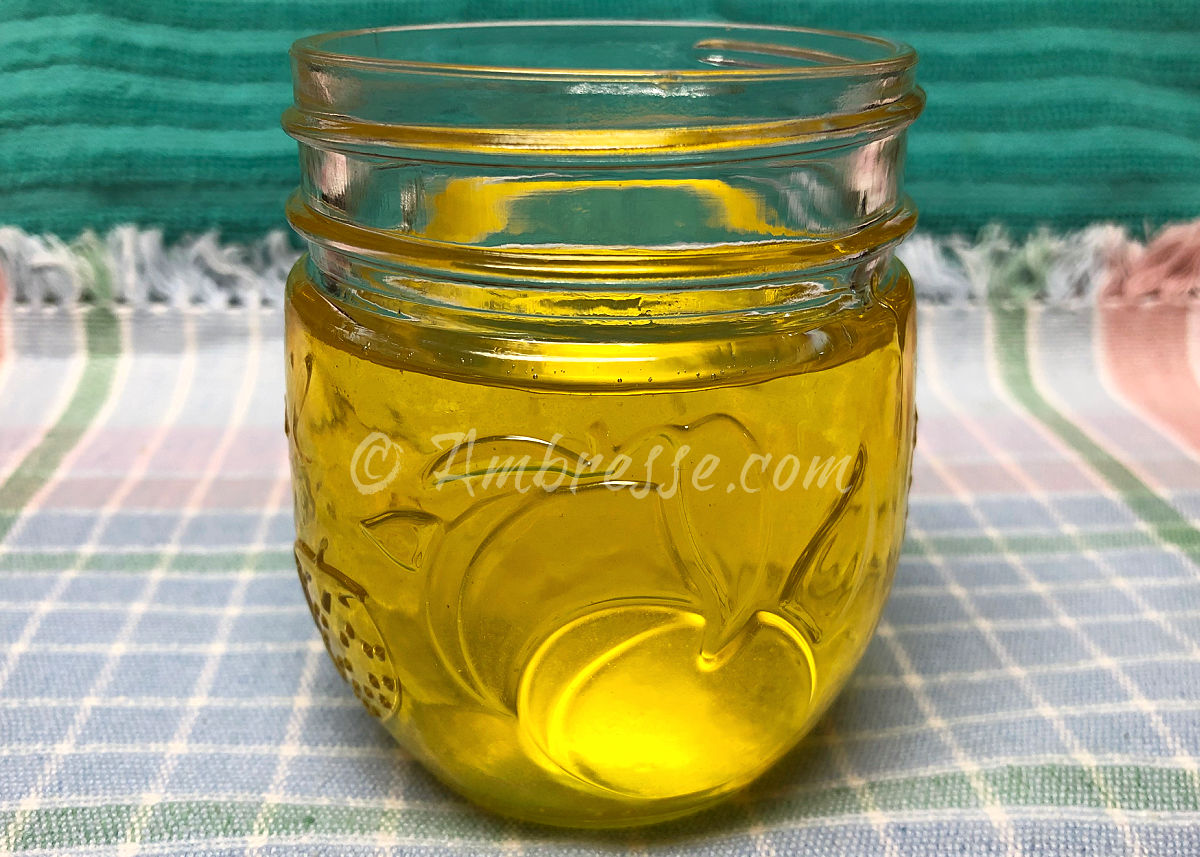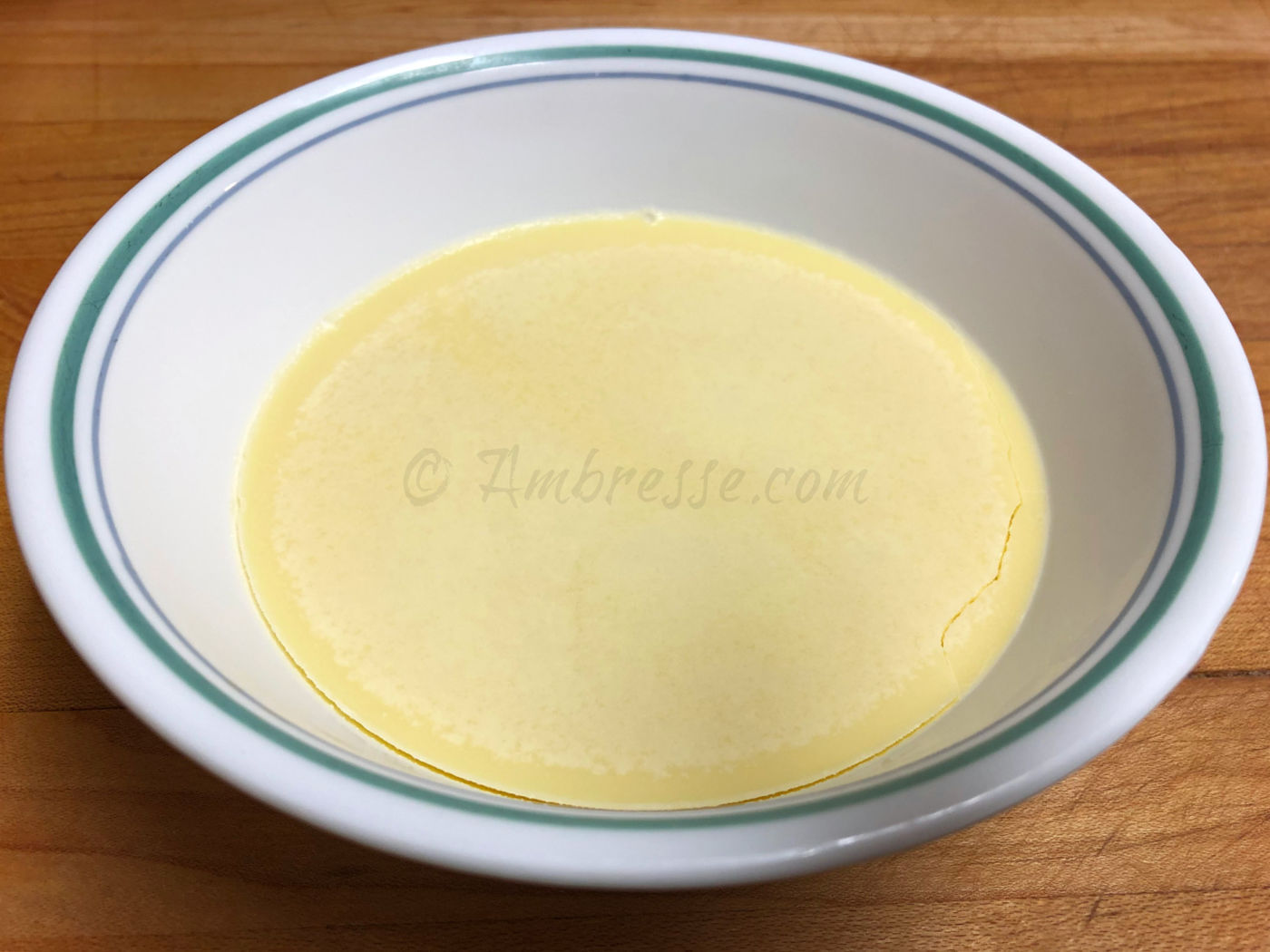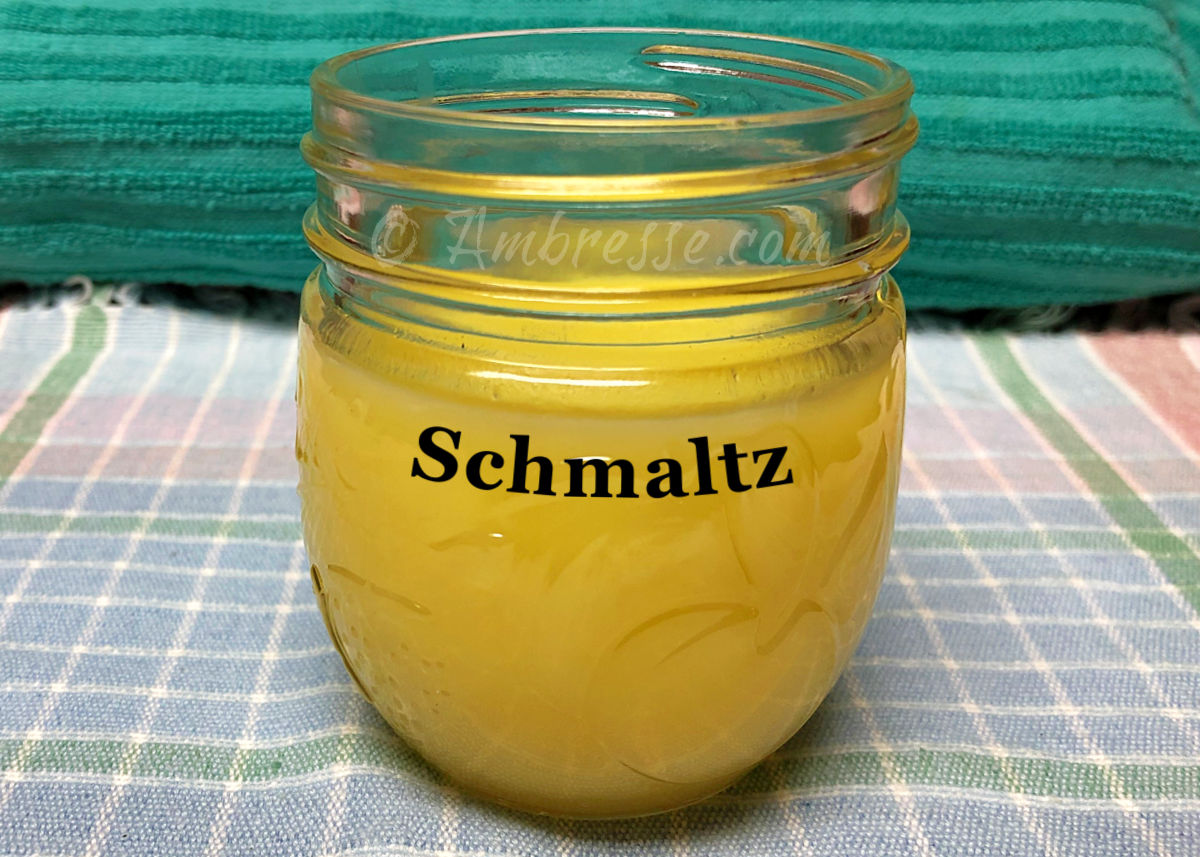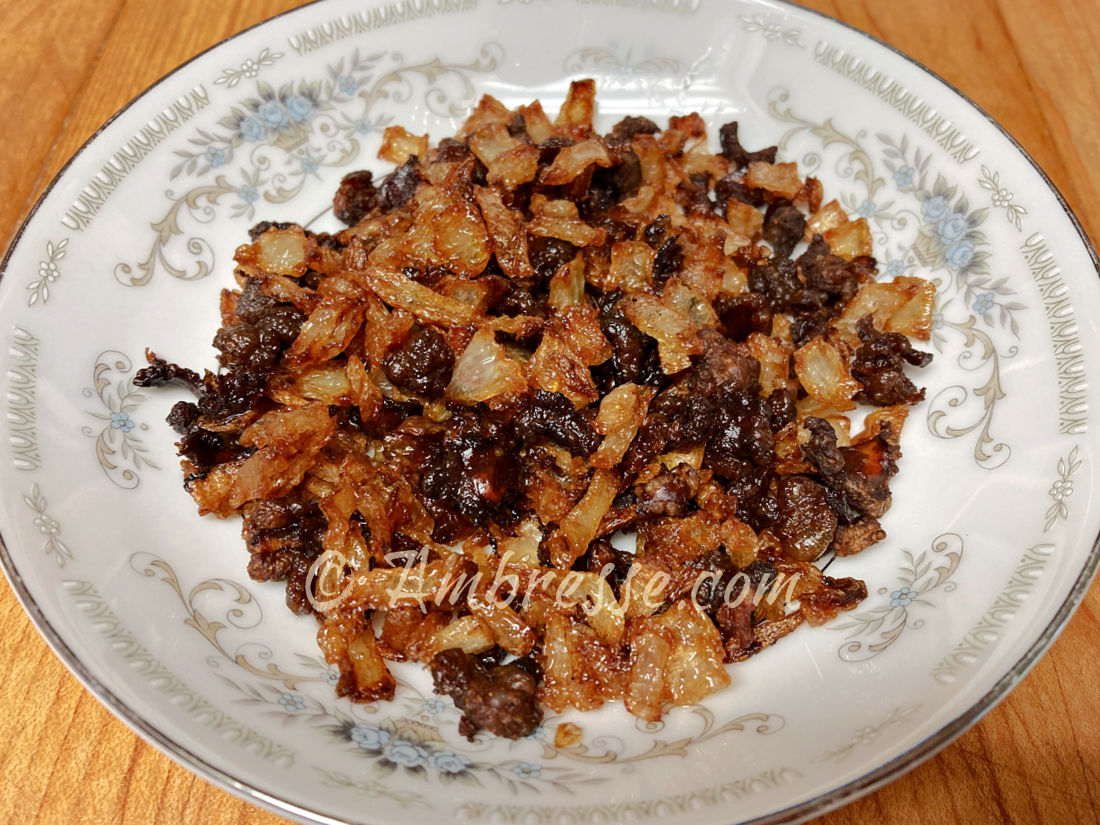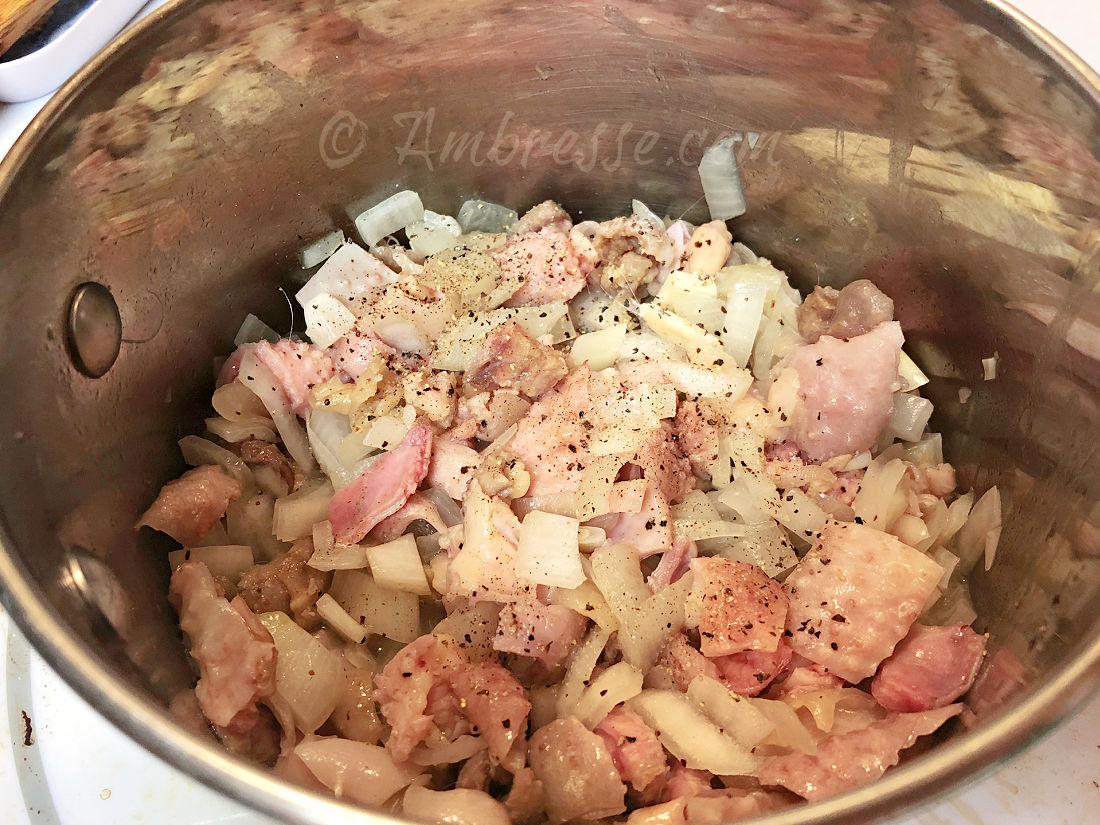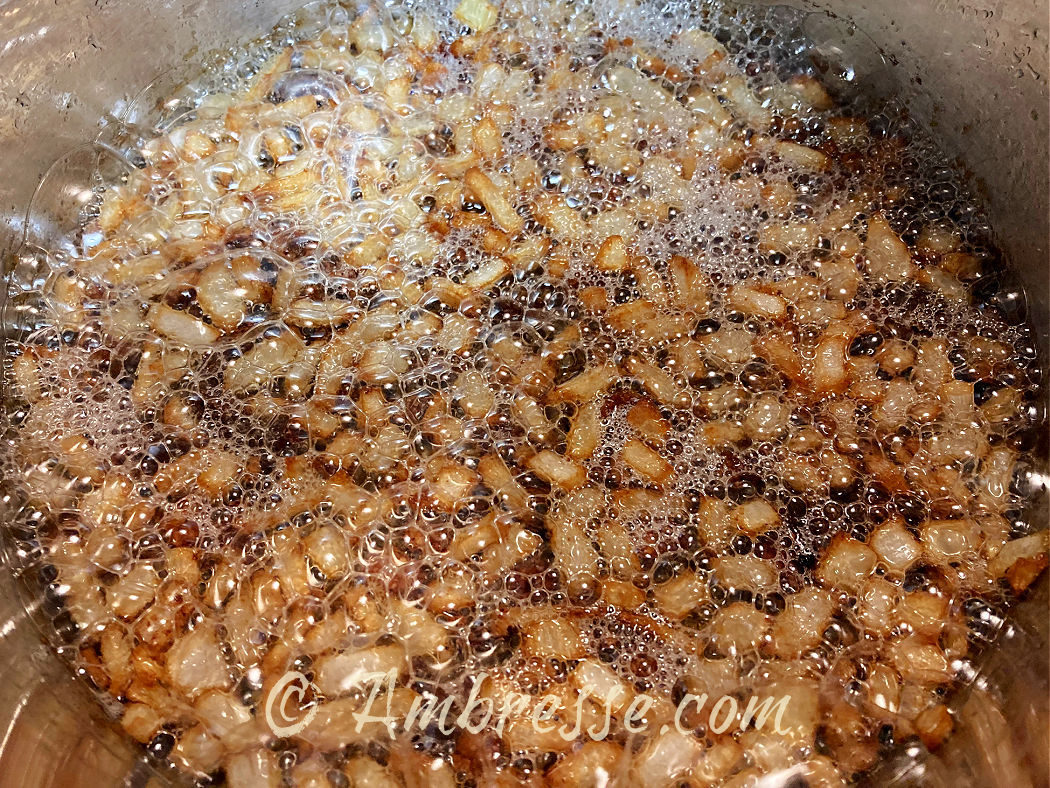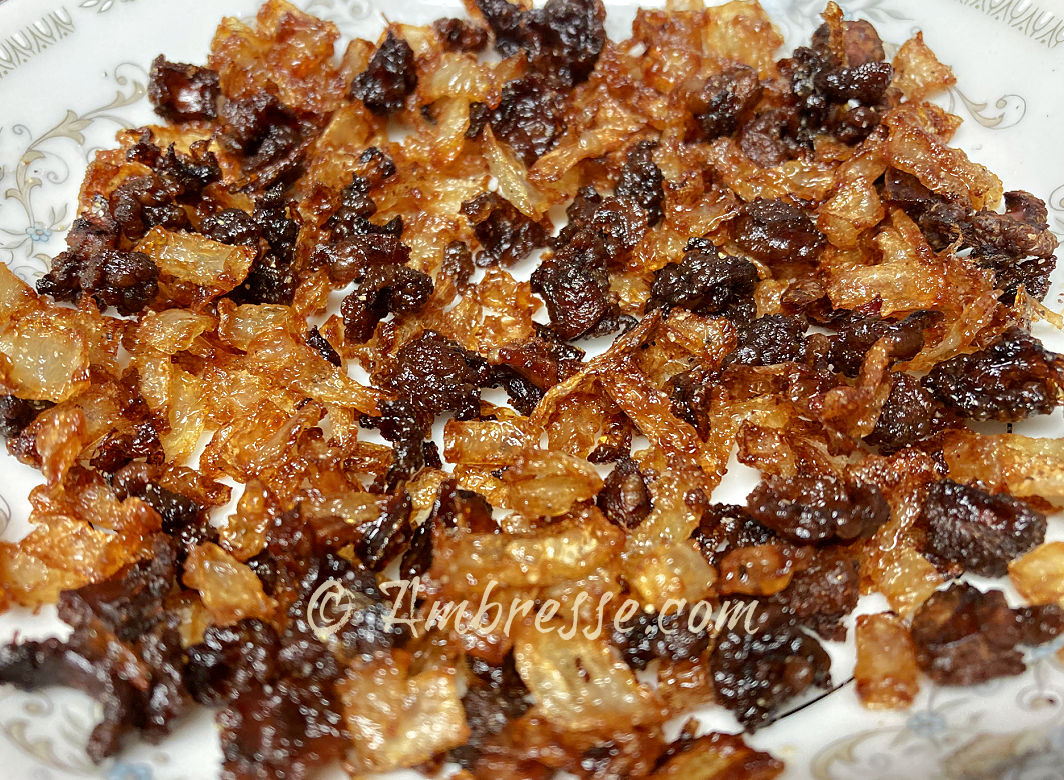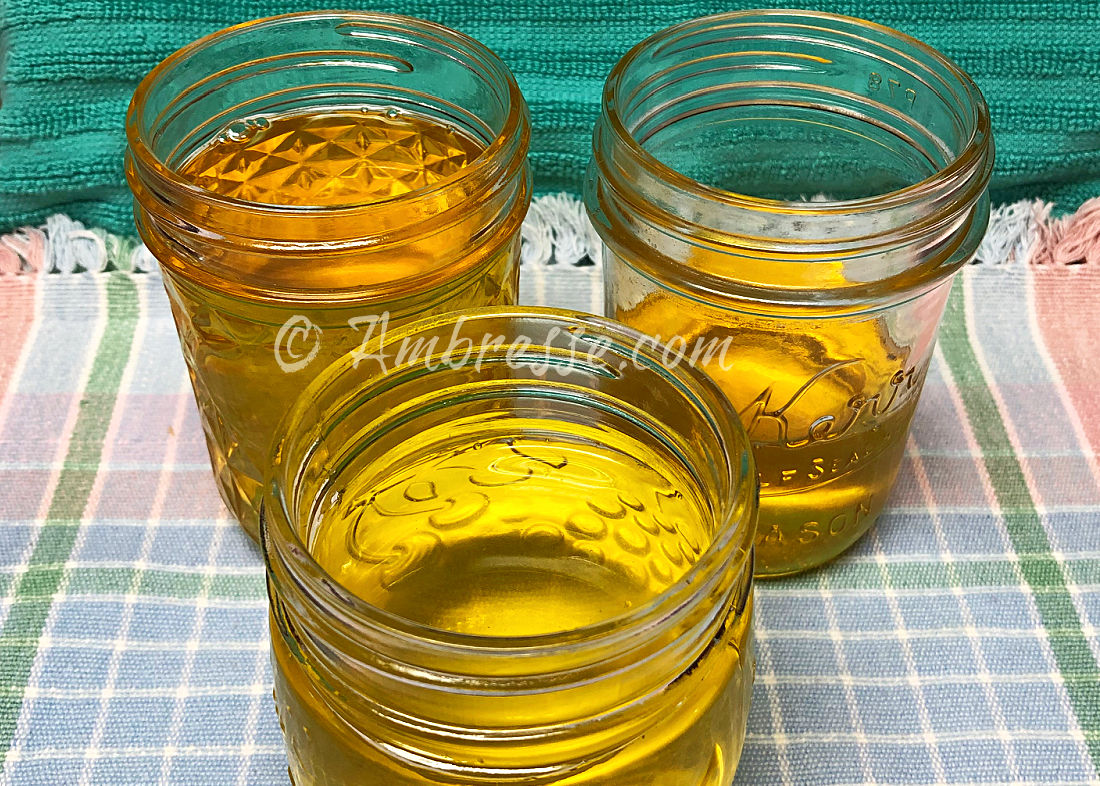Schmaltz
Schmaltz, that most glorious of rendered animal fats - other than butter, of course - may be doubly flavorful when sourced from American Bresse chickens...
What is Schmaltz?
Schmaltz is a soft and creamy fat with a pleasing buttery taste. It is nothing more than rendered chicken fat which has been melted out of chicken skin and tissues into a pure oil.
Rendering releases the oils out of the tissues, resulting in hot liquid rendered chicken fat (schmaltz), and cracklings, the richly browned crispy connective tissue and any skin that was cooked during the process of rendering chicken fat.
Chicken fat is mainly sourced from chicken skin, but also adding the solid fat pads around the neck and shoulders, and the fat from the abdomen at the tail.
Plus, American Bresse chickens have the ability to deposit multiple ribbons of fat in between all the various muscle groups, which if extensive enough can also be pulled away from the meat and saved for rendering schmaltz. Some cooks also skim off the excess fat floating on top of a pot of cooked chicken or chicken bone broth and add it to a simmering pan of rendering schmaltz.
Clarifying Terms...
- Schmaltz is rendered poultry fat, including chicken, turkey, duck, and geese.
- Lard is rendered animal fat from pigs.
- Tallow is rendered animal fat from cows.
- Ghee is rendered butter fat. Another term for ghee is clarified butter.
Lard, tallow, and ghee become very hard when refrigerated. Schmaltz - rendered poultry fat - is soft enough to scoop out of a mason jar with a spoon or fork, whether room or refrigerator temperatures.
Why Schmaltz?
Schmaltz is wonderful to cook with because the depth and complexity of its flavor richly enhances the flavors of most any recipe's ingredients. On the simple side, schmaltz can be used to add a touch of fat and flavor to many recipes.
That same unique punch of intense poultry flavor that earns the American Bresse Chicken the moniker "poultry of kings, and queen of poultry," seems also to be imparted into the schmaltz.


Is Schmaltz Healthy?
Is rendered chicken fat healthy? It's a fair question, since schmaltz is 100% fat. So is fat bad for you? I am sure that it is possible to over-do the dietary intake of any nutrient, including fats.
Per every tablespoon of schmaltz, the make-up of chicken fat breaks down like this:
- 3.8 grams saturated fat
- 6 grams monounsaturated fat
- 2.5 grams polyunsaturated fat
- 11 mg cholesterol
According to Facty.com4, the balance of fats in schmaltz tends to support high-density cholesterol, which helps to maintain clean arteries.
This is why it is a problem that dietary "authorities" in America have madly pushed a non-fat agenda on the general public for more than sixty years. As the populace continues to become more and more obese, logic should tell us that there must be much more to the story than the current fat-is-bad explanation. In fact, could it be that we've restricted from our diet the very thing - fats - that work to balance and empower health and energy?
Perhaps the fat phobia that set in during the mid-twentieth century is finally beginning to fade into the rear view mirror? More and more uncompromised studies are coming into the public awareness that demonstrate the health benefits of animal fats, including schmaltz.
I'm not a scientist, though I am a retired registered nurse. My deep interest in all things nutritional led to the research and writing of the page: Is Fat Bad for You? Read it and see what you think...


Cooking With Schmaltz
With the general vilification of animal fats over the last decades, Americans had virtually lost the art of cooking with schmaltz. (The FDA cast disdain on butter too, but buttery goodness was well nigh impossible to give up.)
Kosher eating rules5 may be the reason why the use of savory schmaltz did not entirely vanish.
It is thanks to finishing American Bresse chickens that I discovered the buttery goodness of schmaltz. I now use it at will in the kitchen.
Cooking kosher is a Jewish thing. Among other rules, kosher means that meat and milk are not consumed at the same meal. This regulation is taken from a sentence in the Torah - Exodus 34:261 - which admonishes the children of Israel not to boil a calf in its mother's milk. This instruction is taken to forbid the eating of dairy products with meat products.
Schmaltz, a meat product, has a rich flavor described variously as buttery, as somewhat nutty, or as carameled richness. It adds a deep savor to any recipe, including many traditional Jewish recipes, both for everyday meals and for High Holiday meals, such as Passover. What's not to like about being able to add the richness of butter without the dairy product itself?2
How about using schmaltz for baked goods? According to Michael Ruhlman in The Book of Schmaltz3, "Schmaltz can replace butter in baked goods for extraordinary effects" (3). What? Schmaltz in cakes or cookies?? Yes! Ruhlman offers the reader a schmaltz oatmeal cookie recipe: "The schmaltz does have a great effect here - it doesn't make the cookie taste like chicken, but it does give it a savory depth to balance the sweetness" (152).
Schmaltz can also be used for simple purposes - as a flavorful oil in which to sauté vegetables, to enhance other flavors, or to use as a delightful spread on toast, garnished and seasoned to taste, instead of using butter or cheese.
How to Make Schmaltz
Making simple schmaltz is very easy, since in the truest sense of the word, schmaltz is nothing more than the rendered fat of poultry (chicken, duck, geese, turkey).
The amount of chicken fat and skin that you choose to render is up to you. To collect an amount sufficient for your needs, you can save and freeze the excess fat and extra pieces of raw chicken skin from meals of chicken until you've saved up enough chicken fat and skins to satisfy your purposes.
How to Render Chicken Fat into Schmaltz
Chop the fat, connective tissue, and pieces of skin into one-half-inch pieces, and simmer in a saucepan. Stir from time to time until all the oil has melted out of the tissues. What remains is hot liquid schmaltz and rich brown crispy cracklings. Pour the hot oil through a sieve into a container such as a mason jar, and set aside the cracklings in a paper-towel-lined bowl.
If you render a couple cups of solid fat/skin, you should end up with roughly 1/2 - 3/4 cups of schmaltz.
Don't Discard the Cracklings!
Don't throw away the cracklings! Drain them on paper towels and season them to taste while still moist with, for example, salt, garlic powder and/or additional spices. Cracklings can be used as a garnish over salads, vegetables, and casseroles.
Plan ahead, and make your schmaltz with onions added! Adding onions makes for some fantastic-tasting cracklings. Kosher recipes call these onion-y cracklings gribenes.
Gribenes
Gribenes (pronounciation is grih-ben-ess), are the amazing little sibling of schmaltz. Since you're already rendering chicken fat to make schmaltz, there will certainly be cracklings left over once the schmaltz is drained away into a container. If the process also includes adding and caramelizing onions, you will be left with two truly delicious products and no waste: schmaltz and gribenes.
Gribenes can be eaten as a delicious snack. They supply excellent energy because they are low in the simple carbs that tend to spike and then tank the blood sugar.
One can also use gribenes as a topping or a garnish for other dishes, such as potatoes, salads, vegetables, casseroles, omelets, and other main dishes.
Heck, you can even replace bacon with seasoned gribenes, they are THAT good. (Bubbie would never dream of cooking with bacon, which is why she loves her gribenes).
How to Make Schmaltz and Gribenes
Ingredients: (This recipe can be doubled, tripled, quadrupled...!)
- Approximately 2 cups of solid chicken fat, connective tissue, and chicken skins, chopped into one-half to one inch ribbons or cubes.
- Add a small amount of water to prevent early burning as the ingredients are heating through and beginning to boil/simmer, say, 1/4 cup (60cc).
- 1 med onion, finely diced
- Dusting of salt to taste
Process:
- Bring the pan with water and chicken fat and skin to a boil and then reduce heat to a simmer, allowing the chicken fat to render out of the tissues. Stir occasionally; you don't want the fat to overheat or the skin to stick to the bottom of the pan and burn. The best schmaltz is a rich light golden yellow without a hint of burn or roasting.
- When the cracklings begin to show signs of browning, add the diced onions.
- Continue to simmer the cracklings in the schmaltz oil until they are crisp and brown, yet still chewy.
- Pour off the schmaltz into a mason jar, or other sealable storage container, by straining through a couple layers of cheesecloth.
- Place the cracklings and caramelized onion in a bowl lined with a paper towel. These can be stored in the refrigerator for a week...if they last that long!
Es gezunterhayt!
Gribenes taste spectacular.
Seriously, schmaltz and gribenes should be a regular part of the American diet. Give it a whirl!! I have no doubt you will be glad you did.
Other Uses for Schmaltz: Hair and Skin Care Products
Schmaltz can be used in hair and skin care products. The assault on animal products has taken its toll in the personal products industry, but homesteaders that make their own home-prepared products can easily use rendered chicken fat in their preparations. Products that can be made at home include:
- Soaps
- Shampoos and beard washes
- Salves and creams
- Lip Balm
The fatty acids found in schmaltz moisturize hair and skin, and additionally supplement the skin and hair with vitamins and nutrients. Their emollient properties help to protect the skin by forming a barrier between the skin and the environment and softening dry and chapped skin.
Infuse the product with the essential oil of your choice in order to add a pleasant odor to your home-prepared personal products.
Where to Buy Schmaltz
Commercially prepared schmaltz is not readily available.
Over the last fifty years the powers that be have worked very hard to convince society that fats are the enemy of health. Therefore, demand for the nutrition that powers hard work has greatly dropped.
Schmaltz drifted out of the public consciousness, further suppressing demand for this amazing oil.
If you do not render your own chicken fat, our research reveals that there ARE a few commercial sources where one can buy schmaltz. We hope the products are not sold out...
- Fatworks.com sells all kinds of animal fats, including schmaltz. 7.5 ounces of free-range organic chicken schmaltz will set you back by $17.95 (before tax, shipping and handling): Buy Schmaltz from fatworks.com.
- Amazon.com sells schmaltz. I typed the term "chicken schmaltz" into the search bar, and all of the schmaltz listed for sale was sourced from duck fat. Oh well, duck is still poultry. Or, make your own like I do.
- Schmaltzonline.com is another source, and they acknowledge that schmaltz is a hard item to find at times: Buy Schmaltz from Schmaltzonline.com. Eight ounces will cost you "only" 13.49. Some kosher recipes may call for the entire jar.
You will LOVE the flavor and the health benefits of the schmaltz and gribenes that you produce from your own American Bresse Chickens!
- Home
- All the Recipes
- Schmaltz
References
- "...You shall not boil a young goat in its mother's milk" (Exodus 34:26) is a statement within a passage describing the offering of one's firstfruits to G-d.
- https://www.allrecipes.com/article/what-is-schmaltz/, accessed July 17, 2023.
- The Book of Schmaltz: Love Song to a Forgotten Fat, by Michael Ruhlman. Little, Brown and Company.
- https://facty.com/food/nutrition/schmaltz-more-than-luck/, accessed Aug 10, 2023.
- https://www.jewfaq.org/kosher_dietary_laws, accessed Aug 11, 2023.
- https://www.saveur.com/gribenes-modern-jewish/, accessed Aug 22, 2023.
Overheard...
Tasty Recipe! "I processed my first batch of Bresse... Today I roasted one according (somewhat) to the recipe posted on Ambresse. It was delicious! Tender, moist and succulent... So happy I chose this breed!" (B.E., MN, 12/11/2024).
Success: "I can't believe all the inquiries we get through your website. And it's been a great resource to send people to who are interested in the (AB) breed" (Utangard Farm, NH, 5/5/2025).
Informational: "Your site has the first accurate information about American Bresse chickens that I have seen in English. Thanks for your diligent work" (L. Wooton, NC, 12/17/2024).
Translate This Page
Traduire Cette Page
Traduzca Esta Pagina

News
American Bresse Breed Club web pages can be found under the Breed Club tab on the navigation bar. Any changes in Club status will be posted here!
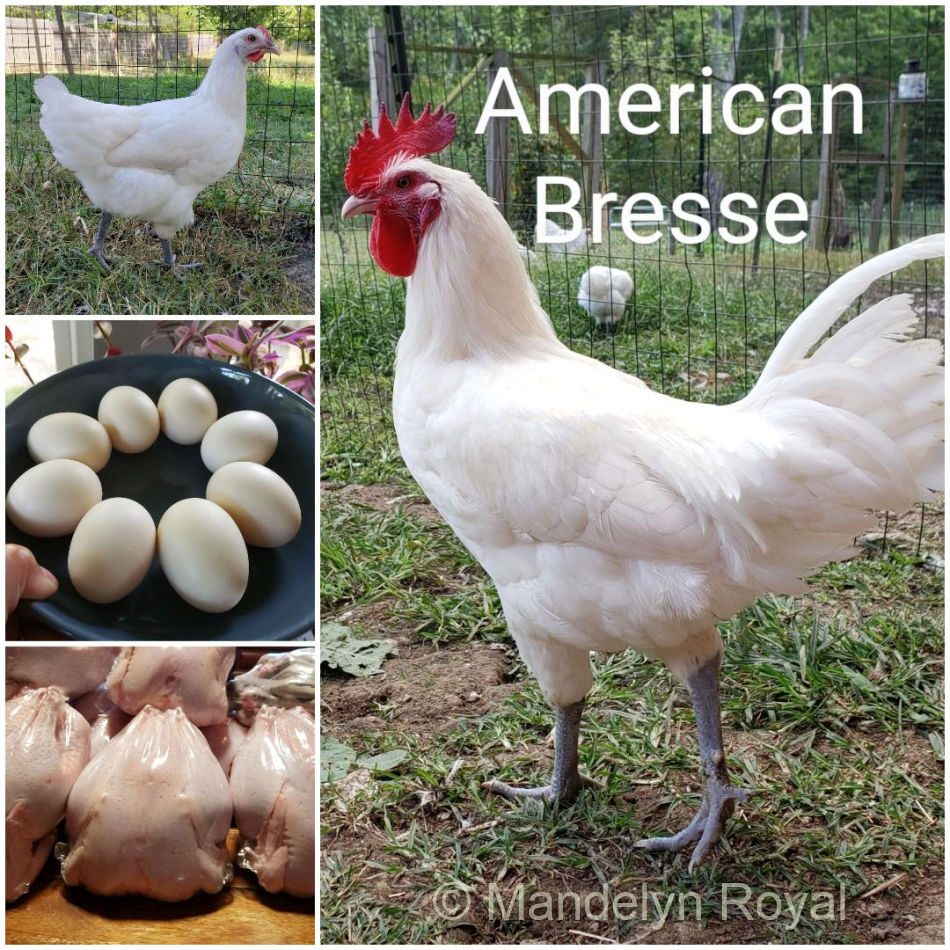
Photo credit: Mandelyn Royal.
